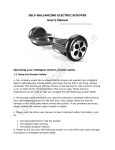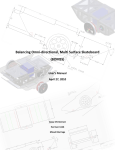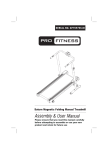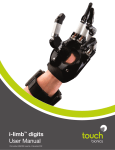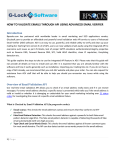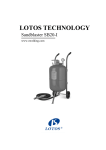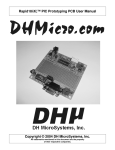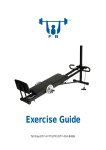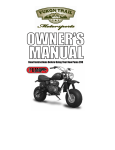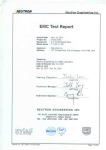Download System Design and Project Plan
Transcript
Balancing Omni-directional, Multi Surface Skateboard (BOMSS) System Design and Project Plan October 13, 2009 Casey Christensen Harrison Cobb Misael Marriaga Table of Contents System Design …………………………………………………………………………………………………………………………. 2 Background ……………………………………………………………………………………………………………… 3 System Overview ……………………………………………..…………………………………………………… 3 Block Diagram ……………………………………………………………………………………………………………... 5 Functional Decomposition of Blocks ……………………………………………………………………….……6 Project Plan …………………………………………………………………………………………….…………………………… 8 Organization and Management …………………………………………………………………….…….. 9 Work Breakdown Structure – Fall 2009 …………………………………………………………...... 10 Work Breakdown Structure – Spring 2010 Estimated Costs and Budgeting ………………………………………………….…….. 12 ……………………………………………………………………….… 13 Gantt Chart – Fall 2009 …………………………………………………………………………..………… 14 Gantt Chart – Spring 2010 ………………………………………………………….…………………….…… 15 Network Diagram – Fall 2009 …………………………………………………………………………………….. 16 Network Diagram – Spring 2010 Appendices ……………………………………………………………………….… 17 ……………………………………………………………………………………………………………………….. 18 Appendix A (Mechanical Drawings) ………………………………………..………...………………..…… 19 Appendix B (Requirements Specification Document) ……………………………………………….… 23 Appendix C (Data Sheets / Cost Estimates) ………………………………………………………………… 29 1 System Design 2 Background Riding a skateboard can be difficult and discouraging to learn. We will create a device that will allow beginners to quickly enjoy being able to ride a skateboard. It will also have a compact design that allows it to be easily maneuvered in an urban environment. The BOMSS will be a skateboard-style, self-balancing vehicle. Basic design consists of a platform for the rider to stand on, with two independently operated wheels fastened centrally to the underside. The operational components will be contained in water and vibration resistant compartments where they will be protected from collisions with foreign objects. These compartments and the components they contain will be easily accessible to the user, while remaining “hidden” within the structure as to not interfere with the user’s ability to effectively operate the vehicle. The BOMSS will be an enjoyable recreation vehicle for users of nearly any age that are looking for a unique and inventive new way to spend their time. Its maneuverability and ability to operate efficiently in many different environments will make it stand apart from other similar recreation and transportation vehicles. System Overview The design is a two wheeled, self balancing vehicle that provides a dynamic turning radius, meaning that the turning radius is proportional to the velocity of the vehicle, with a near zero turning radius at no forward motion. If the vehicle, for example, it traveling at a rate of 4 m/s, the turning radius will be much greater and therefore more stable than if the vehicle were traveling at a rate of 0.5 m/s, where the radius would be significantly decreased. This will make the vehicle useful and easy to maneuver in an urban environment. The Balancing, Omnidirectional, Multi Surface Skateboard (BOMSS) will utilize accelerometers and gyroscopes to sense the angular position of the skateboard with respect to the horizontal plane. This information will then be used as an input in its controls algorithm. The vehicle will be maneuverable in the forward and aft direction, as well as steering left and right. Angular position and angular rate will be monitored by the accelerometers and angular rate sensors (gyros). These sensors will send a signal to the microcontroller that runs controls algorithm based on the equations of motion of the skateboard-rider system. Once the velocity of the skateboard necessary to maintain the level platform is calculated by the microcontroller, it will send a signal that will adjust the power delivered to the motors to achieve such velocity. Safety features will include a minimum rider weight and an anti-theft key. Before power is delivered to the system, the rider must insert a removable anti-theft key and then fully depress a mechanical weight sensor. Power is provided by a rechargeable, on-board battery. 3 For further detail describing the operation, refer to the requirement specifications document located in Appendix B. Deliverables for this project will include the self balancing skateboard capable of a runtime of approximate 1 hour, anti-tamper key, user’s manual, and all relative schematics, analysis, drawings, and documentation showing test results. 4 5 Functional Decomposition of Blocks Physical Input Parameters: These parameters include the actual mass of the skateboard and its calculated rotational inertia, as well as average estimates of the rider’s mass, rotational inertia, and height. Equations of Motion: Provided with physical input parameters, these equations will be integrated as part of the controls algorithm into the software that enables the board to maintain a level plane. Balance Sensors: These sensors include an accelerometer and an angular rate sensor (gyroscope). The accelerometers will provide the microcontroller with readings of the component of gravity perpendicular to the skateboard with the purpose of calculating the board’s angular position. The angular rate sensors will provide readings on the angular velocity of the skateboard to the microcontroller, which will calculate the direction in which the skateboard is tilting. These calculations will be used to determine the proper adjustments of the motors to keep the skateboard on a level plane. The accelerometer will require a supply of no less than 2.2 V and no more than 3.6 V. The output signal will be no less than 289.5 mV/g and no more than 326.5 mV/g. The accelerometer reads ±4 g. The angular rate sensors will require a supply of no less than -0.3 V and no more than 6.0 V. It will have a typical sensitivity of 2.0mV/°/s. Turn Sensors: These sensors include an accelerometer and an angular rate sensor (gyroscope). These sensors will perform in the same way as the balance sensors but with the purpose of sensing the angular position and angular velocity of the skateboard about an axis perpendicular to the axle of the wheels and on the horizontal plane. The turn sensors will provide the acquired information to the microcontroller, which will send a signal to adjust the motors to turn. The sensors will be the same as the ones used for balance, though properly arranged to sense turning. Software: The software is the electrical manifestation of the equations of motion. Using the derived equations along with the collected sensor values, the software will calculate the duty cycles needed for the microprocessor to precisely control the motors for maintaining a level platform as well as maneuvering the skateboard. Microprocessor: This unit will compile the sensor information and communicate with programmed software. Once the sensor information is collected, the derived equations of motion can be applied through software to calculate the necessary duty cycle, which controls each wheel’s motion independently. The microprocessor may require up to four (4) A/D (Analog to Digital) ports for sensor input, and will require multiple ports for output to the motor controller. 6 Voltage Regulator: The voltage regulator contains hardware to supply various voltages necessary to run the 1) balance and turn sensors, 2) microprocessor, 3) motor controller, and 4) possibly each motor. Preliminary voltages required may include +/5V, +12V, and +24V. Power Source: The chosen power source will be a 24V rechargeable battery, with a capacity rating of at least 12 Ah. Options include SLA, NiMH, and NiCd. Motor Controller: This unit will accept the signals from the microprocessor and control both the speed and direction of each independent motor. Left and Right Motors: Motors selected are 350 watt motors. Each motor is independently controlled by the microprocessor via the programmed motor controller. Based on inputs from the accelerometers and angular rate sensors, the controller will drive the motors appropriately to maintain balance as well as produce motion. Battery Level Display: The battery level display is an LED voltage display typically used in remote controlled aircraft. This will provide the user with instant information on the state of charge of the battery. On/Off switches: There are two individual On/Off switches, both of which engage/disconnect power from the battery. Note that neither switch will provide any function to the BOMSS unless the aforementioned anti-theft key is securely in place. The first switch is a “main power” push button switch that, when engaged, will allow the BOMSS to be powered and ready for a rider. However, it does not allow for any unauthorized motion or balancing at this point, as the second switch also needs to be engaged for full operation. The second switch is a safety switch that is activated by a specified weight depressing the foot platforms. Without this second switch in place, if the main power button were engaged and the platform were inadvertently brought level without a user being onboard, the BOMSS would begin its balancing operations and could become unsafe. This safety concern required the addition of this second weight sensor switch. 7 Project Plan 8 Organization and Management Casey Christensen – Casey is a senior level mechanical engineering student, and was selected as the team lead for this project. He is responsible for determining mechanical dimensions and materials used in construction, as well as performing finite element analysis of stresses and deformations to eliminate the possibility of a stress related failure of the frame or any other mechanical element. Also, alongside Misael, he will be formulating the equations of motion that will ultimately be used to control the BOMSS. Casey will work with Misael to select an appropriate gear ratio so as to insure little or no undue stress on any particular component. Casey will provide CAD drawings and schematic specification sheets. Throughout the entire project, Casey will be responsible for ensuring that the project is moving at an appropriate rate and that is stays on course. Harrison Cobb – Harrison is a senior level computer engineering student, with a 70/30% split between electrical engineering and computer science, respectively. He is the sole computer engineer on the project and is responsible for selecting and programming the microprocessor, developing and building circuit boards, and determining appropriate motors and battery. Also, he will be working with Casey and Misael in the general construction of the project. Harrison will provide circuit simulations and a professionally etched circuit board. Misael Marriaga – Misael is a senior level mechanical engineering student. He is responsible for selecting accelerometers and angular rate sensors (gyros). He is also developing the equations of motion necessary for control and he will perform finite element analysis of stresses and deformations to eliminate the possibility of a stress related failure of the frame or any other related mechanical element. Misael will develop the control system algorithms that will be used and programmed into the microcontroller by Harrison. He will also work with Casey to select an appropriate gear and chain ratio and help build the frame. The tasks listed above for each engineer are not all inclusive. All members are versatile enough to assist each other in their respective responsibilities; therefore the above task schedule is subject to change. All members are responsible constant documentation of all work completed as well as gathering and presenting their information and progress in the group’s biweekly presentation of an A3 status report. 9 Work Breakdown Structure - Fall 2009 Task Activity F1.0 Requirements Specifications F2.0 F3.0 Overall System Design Description Document stating what the project will accomplish in detail Design overall project in detail Mechanical and Power Analysis Calculating equations of motion, stress analysis, and power requirements F3.1 EOM F3.2 Stress Analysis F3.3 F3.4 Torque Requirements Power Deliverability F4.0 Structure Design Calculate EOM of the system Finite element analysis of axles and frame Calculate torque requirements from EOM Determine power using electrical analysis Design the dimensions and materials for housing F4.1 Dimensions of Frame F4.2 Materials for Construction F5.0 F5.1 F5.2 F5.3 F6.0 F6.1 Power Supply Design Switches Voltage Regulator Low Battery LED Display Inertial Measurement Unit Interfacing Design Research Ensure dimensions are realistic Choose lightweight, strong and durable materials Battery circuit providing inputs to limiters and circuitry Choose switch that is easily depressed Deliverables / Checkpoints General ideas for the project in written document Brainstorming ideas, produce working design Equations of motion, finite element analysis, Electrical Power Analysis Calculations and derivation Data from analysis Calculations and derivation Calculations Design details, knowledge of technology, CAD drawings CAD drawings People Duration (weeks) Resources C,H,M 4 PC C,H,M 9 PC C,H,M 8.5 PC M1,C2 1.5 Textbooks M1,C2 4 PC M 1 EOM H 2 Textbooks C 1.5 PC C1,M2,H3 1 PC C 0.5 PC H 2.5 PC H 1 PC H 1 PC H1,C2 0.5 PC M 2.5 PC M 2.5 PC Design details Design details, knowledge of technology Design details, knowledge of technology Design details Knowledge of technology Design details, knowledge of technology Research options Research Options Accelerometer and angular rate sensors that provide angular position for the control system Determine possible components of unit Knowledge of technology 10 Work Breakdown Structure - Fall 2009 (continued) F7.0 Parts Selection F7.1 Motors F7.2 Axle and Wheel Assembly F7.3 F7.4 Gearing and Chains Microcontroller F7.5 Sensors F7.6 Battery F8.0 F9.0 F9.1 System Analysis System Design and Project Plan Report F9.2 Presentation F10.0 Final Design F10.1 Report F10.2 Presentation C1.0 Documentation C2.0 Project Management Make final decisions on parts to be used Choose by power and torque requirements Choose materials that will hold specified weights Choose gears and chains according to ratio and torque requirements Find board that is sufficient for all components Choose number of axes and sensibility Choose size and power deliverability determined by motor requirements Analyze entire design to test for functionality Breakdown of design and build process with detailed scheduling Write detailed report regarding the ideas mentioned above Present ideas to faculty Finalize the design and no more changes can be made past this point Write detailed report regarding the ideas mentioned above Present ideas to faculty Continue to log all work into laboratory books Oversee project progress and keep the project on course Order parts needed and documentation of all purchases Knowledge of technology Design details C,H,M 10 PC M 1.5 PC C1,M2 1 PC C1,M2 2 PC H 3 PC M1 1.5 PC C,M,H 1 PC C,H,M 4 PC, SolidWorks, AutoCAD, MultiSim C,H,M 2 PC C1,H2,M2 0.5 PC C,H,M 0.5 PC C,H,M 2 PC C1,H2,M2 0.5 PC C,H,M 0.5 PC C,H,M 17 PC, Notebooks C 17 Class Literature Design details Knowledge of technology Knowledge of technology Knowledge of technology Test dimensions, power requirements, torque requirements, data analysis Report, visual aided presentation Report PowerPoint Report, visual aided presentation Report PowerPoint Sufficient documentation to depict project progress Smoothly operating project 11 Work Breakdown Structure - Spring 2010 Task S1.0 Activity Description Parts Assembly and Testing Assemble all parts and verify they work correctly Build housing for all components Create and test circuitry S1.1 Build Structure S1.2 Compile Circuitry S1.3 Board Etching S1.4 Sensors S1.5 S1.6 S1.7 S1.8 S1.9 S2.0 S3.0 S4.0 Power Supply Microprocessor Motors Gears and chains Wheels Programming Project Status Presentation System Integration Design and order circuit boards Build circuits and verify that sensors operate according to specifications Mount battery to structure and attach to circuitry Build circuitry and verify correct operation of device Connect motors to power and verify correct operation and functionality Attach gears and chains and verify correct operation Attach wheels to structure and verify mounting to be stable Write code for microprocessor and download code to the device Presentation of the project's status Compile all individual components to build the prototype Deliverables / Checkpoints Working parts, test data Finished device housing Finished main circuitry, test data Professionally made circuit board Proper sensor readings, test data People Duration (weeks) Resources C,H,M 10 Various Equipment C1,M2 3 H 4 H 4 Outsourcing M1,H2 2 Evaluation board, oscilloscope H1,C2,M2 2 Oscilloscope H 2 PC, evaluation board C 0.5 Power supply, oscilloscope C1,M2 0.75 Power equipment C 0.5 Power equipment H 10 PC, evaluation board C,H,M 0.5 PC C,H,M 3 Work shop Metal and plastics, shop Evaluation board, oscilloscopes Adequate power supply Working device, test data Functional motors, test data Smooth operation, test data Attached wheel to shaft, free movement, no binding, functional component Operational code, test data Report, visual aided presentation Assemble product, test data 12 Work Breakdown Structure - Spring 2010 (Cont.) S5.0 S6.0 System Testing Finalize Prototype Test the prototype per specifications requirements document Verify correct operation and prepare for final demonstration Test data C,H,M 3 PC, evaluation board, oscilloscope C,H,M 6 PC, evaluation board, oscilloscope Working prototype S7.0 Final Project Presentation Present the prototype Report, visual aids, prototype C,H,M 0.5 PC C1.0 Documentation Continue logging all research and work done Sufficient documentation to depict project progress C,H,M 15 PC, Notebooks Oversee project progress and keep the project on course Smoothly operating project C 16 Class Literature C2.0 Project Management Estimated Costs and Budgeting Items Costs Possible Vendor Date of Cost Estimate Main Drive Wheels (2), front wheels (2) Lexan Sheeting (12) Center axle Bar stock for "safety" wheels 68 Tooth Rear Sprocket For #25 Chain for main shaft (2) Sprockets for motor shaft (2) #25 Chain With Master Link (2) Dual Axis Gyro $20.00 $4.39 sq. ft $12.51 $4.54 Bike City, Searcy AR estreetplastics.com mcmastercar.com mcmastercar.com 10/3/2009 10/9/2009 10/3/2009 10/3/2009 $17.95 each electricscooterparts.com 10/4/2009 On motor $8.40 each $14.95 Samples ordered $50.00 each ~ $100.00 $100.00 ~ $60.00 ~ $332.27 $850.00 electricscooterparts.com electricscooterparts.com sparkfun.com 10/3/2009 10/3/2009 10/3/2009 freescale.com 10/1/2009 electricscooterparts.com 10/3/2009 advancedbattery.com piclist.com 10/3/2009 10/4/2009 Accelerometers (2) 350W motor (2) Microprocessor Lead acid battery Pro-Etched Circuit Board Contingencies & Misc. Total Estimated Cost 13 14 15 16 17 Appendices 18 Appendix A (Mechanical Drawings) **NOTE** The Dimensions that were chosen for the technical drawings are specific to this design only. The limits on size were dependent on the battery size, motor footprint, estimated circuit board size, wheel diameter, and foot platform area. The dimensions are subject to change, but as drawn, all components will fit within the frame with no complications. 19 20 21 22 Appendix B (Requirements Specification Document) 23 Balancing Omni-directional, Multi Surface Skateboard (BOMSS) Requirements Specification Harrison Cobb, Misael Marriaga, Casey Christensen Overview: Riding a skateboard can be difficult and discouraging to learn. We plan to create a device that has an easy learning curve, allowing beginners to quickly enjoy being able to ride a skateboard. It will also have a compact design that allows it to be easily maneuvered in an urban environment. The BOMSS will be a skateboard-style, selfbalancing vehicle. Basic design consists of a platform for the rider to stand on, with two independently operated wheels fastened centrally to the underside. The operational components will be contained in water and vibration resistant compartments with easy accessibility to the user, clear of any interference, and protected from collisions with foreign objects. The BOMSS will be a desirable alternative to traditional styles of transportation. Operation: Before operation of the BOMSS, a push button switch for the main power (Figure 1) must be “ON” for operation. This will be incorporated into the vehicle’s platform and easily accessible to the rider’s foot. Until the power switch is “ON” the vehicle will remain powerless. Figure 1 A B Figure 1: Position A shows the “ON” position of the switch. Position B shows the “OFF” orientation of the push button switch. For ease and safety, the “OFF” position of the switch was oriented in the compressed position so only one motion would be required to initiate power shutdown. The BOMSS will then provide a safe mounting technique for the user. The start-up sequence consists of two stages, both dependent on the other: 1) The BOMSS will mechanically sense the weight of a rider on the platform, who must weigh no less than 20kg (44lbs) 24 2) The platform must be brought level with the ground Once both criteria are met, the BOMSS will immediately power the onboard motors and maintain a level plane, which is how the rider manipulates movement. Upon leaning in either the forward or backward direction, the skateboard will roll in the direction of tilt. In this manner the skateboard can be moved in a straight path. Upon putting pressure on the toes or heels, the rider can alter the motion of the skateboard in the left or right direction. When the user is ready to get off the vehicle, he/she will come to a complete stop before depressing the push button switch, which will turn the main circuit board “OFF”, causing a complete power down. As an added safety feature, removing weight from the platform will shut down power to the motors. To re-power the vehicle, remount and bring the platform level. As a precaution against theft or unauthorized use, a removable, anti-tamper key will be included. This key must be inserted into its appropriate slot for the BOMSS to operate. Without this key, there is no way to operate the BOMSS. Deliverables: 1. 2. 3. 4. 5. 6. User’s manual Self balancing skateboard with anti-tamper key CAD drawings, electronic schematics, 3D views and analyses Code and flowcharts Report of testing Final report Technical Requirements: 1. The BOMSS will maintain a maximum speed of no less than 4 m/s (13 ft/s) and no more than 10m/s (33 ft/s) for safety concerns. 2. The BOMSS will be powered for a runtime of no less than 60 minutes at 30% maximum speed. 3. A turning radius of no greater than 1mx1m (3ftx3ft) at zero forward motion. 4. The BOMSS will have a low battery indicator light (cutoff voltage to be determined). 5. The BOMSS will be capable of carrying a 91kg (200lbs) adult over dense materials such as pavement and concrete, on both a flat and inclined plane. 6. The BOMSS will weigh no more than 23kg (51 lbs). 25 Testing Plan: To ensure proper operation, the following tests will be conducted: Run Time Test: To test run time, the BOMSS will be required to maintain operation for a total time of approximately sixty (60) minutes. The rider will weigh between 91 and 100 kg (200-220lbs) and will be required to maneuver a predetermined course (refer to Figure 2) around the Harding University campus containing level planes, inclines, and declines over a multitude of surfaces. Riding times can be discontinuous, but a total time of sixty (60) minutes must be summed at an average of 30% of the maximum speed before the battery is recharged. Figure 2 Figure 2: The course the BOMSS will be required to navigate during the test period is indicated in red. The starting and ending place is the Pryor-England Science Center highlighted in yellow. The BOMSS will complete the course at least once to demonstrate its ability to operate in varying surfaces. Care was taken in determining the course as to not encounter any dangerous traffic or intersections and place the tester in harm. Minimum Speed Test: To test the maximum speed, the BOMSS will be mounted, then proven to travel a measured distance in a given amount of time. A stopwatch will provide an adequate amount of accuracy. The distance will be forty (40) meters on a flat, asphalt or concrete surface. Time to travel this distance must be between four (4) and ten (10) seconds. 26 Turning Radius Test: To test turning radius, only a maximum turning radius will be required. The skateboard will be placed inside a taped-off square of one (1) meter by one (1) meter, and then mounted. A satisfactory test will be if the skateboard can be maneuvered a full 360° without leaving the taped square. Draft User’s Manual: Initial setup: 1. Connect the battery. To connect a battery, insert the battery into the appropriate tray in the vehicle and attach the positive (+) and negative (-) leads to their respective cables. *NOTE*: Use caution when connecting the batteries to the circuitry in the vehicle. Reversing the positive and negative leads can cause damage to the batteries and circuit boards. 2. Charging the battery will require a battery charger (not supplied) for the chosen battery. Batteries should be charged for the first time according to the battery maintenance sheet provided, and then as necessary following first use. Operation: 1. Ensure the anti-tamper key is in place as the vehicle will not be operational until this is inserted into the appropriate slot. 2. Set the BOMSS main push button switch to the “ON” position and mount the platform. Bringing the base level to the floor immediately initiates the self-balancing algorithms. The vehicle is now operational and will react to all movements. 3. To move forwards or backwards, lean body in the desired direction of travel. To arrest motion, return to level plane. Turning requires pressure with either the heels or toes, depending on the desired direction of turn. To stop turn, eliminate edge pressure. 27 4. Dismount by depressing the “OFF” button on the base. This completely removes power. Also, the skateboard has a safety feature that immediately halts power to the motors if a loss of weight on the platform is sensed; this is useful in the event that the rider falls from the board. Storage: 1. Set main power push button switch to “OFF”. 2. Store in a cool, dry place. 3. Battery maintenance is supplied in the user’s manual. 28 Appendix C (Data Sheets / Cost Estimates) 29






























